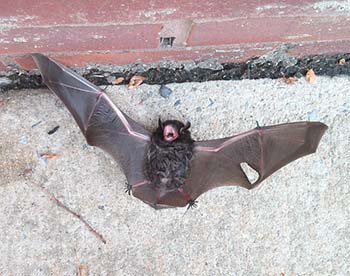(703) 881-3170
Silver-haired Bat Information
Silver-haired Bat Facts

The Silver-Haired bat is listed as Not Threatened here in the state of Virginia. While there are some issues with population loss due to wind turbines, their numbers are above sustainable levels and are not in any danger. These bats are solitary and you can find them roosting alone in trees por sometimes in rock crevices or other narrow cavities near streams or lakes.
These bats are migratory, and you will see them here in Virginia when they are in the middle of migrating in the spring and fall. Although some stragglers may appear here in Virginia during the summer.
Silver-haired Bat Characteristics
At first glance, these bats do not look silver at all with their dark brown fur color. However, the silver color comes from the tips of their hairs, giving the bat an almost greyish brown color. No other bat here in Virginia has this fur color, so if you find a silver or grey colored bat then what you are seeing is a Silver-haired Bat. These bats are usually between 3-4 inches long and has short and rounded ears. Do not handle this bat as this is one of the few species of bat in Virginia that can carry rabies. Please call a professional to remove this bat.
Silver-haired Bat Mating and Breeding
Mating for these bats start in late August, when they are on their way to the more southern states and Mexico to roost for the winter. When they give birth in late June, the Silver-haired bat tends to produce twins. They are able to fly after one month of being born.
Silver-haired Bat Diet
The Silver-haired Bats are opportunistic feeders, and tends to eat what they can get a hold of. But when given a choice, they prefer sof shelled insects such as moths. They have been known to eat spiders and harvestmen as well.
